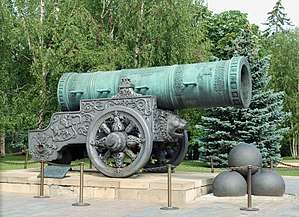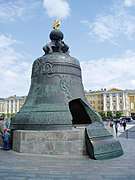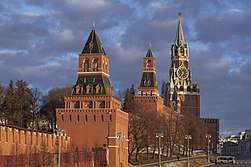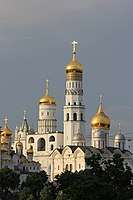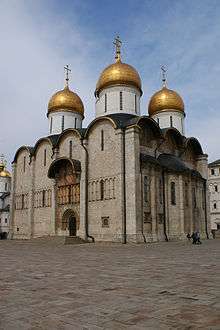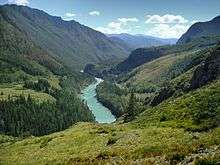Moscow Kremlin
The Moscow Kremlin (Russian: Московский Кремль, tr. Moskovskiy Kreml, IPA: [mɐˈskofskʲɪj krʲemlʲ]), or simply the Kremlin, is a fortified complex in the center of Moscow, overlooking the Moskva River to the south, Saint Basil's Cathedral and Red Square to the east, and the Alexander Garden to the west. It is the best known of the kremlins (Russian citadels), and includes five palaces, four cathedrals, and the enclosing Kremlin Wall with Kremlin towers. In addition, within this complex is the Grand Kremlin Palace that was formerly the Tsar's Moscow residence. The complex now serves as the official residence of the President of the Russian Federation and as a museum with 2,746,405 visitors in 2017.
| Moscow Kremlin | |
|---|---|
| Native name Russian: Московский Кремль | |
 | |
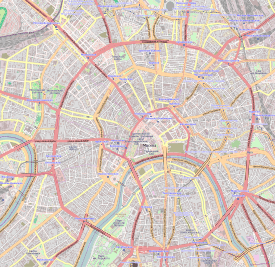 Location in Central Moscow .svg.png) Moscow Kremlin (European Russia)  Moscow Kremlin (Europe) | |
| Location | Moscow, Russia |
| Coordinates | 55°45′6″N 37°37′4″E |
| Area | 27.7 hectares (0.277 km2) |
| Built | 1482–1495 |
| Official name: Kremlin and Red Square, Moscow | |
| Type | Cultural |
| Criteria | i, ii, iv, vi |
| Designated | 1990 (14th session) |
| Reference no. | 545 |
| State Party | Russia |
| Region | Eastern Europe |
The name "Kremlin" means "fortress inside a city",[1] and is often also used metonymically to refer to the government of the Russian Federation in a similar sense to how "White House" refers to the Executive Office of the President of the United States. It previously referred to the government of the Soviet Union (1922–1991) and its highest members (such as general secretaries, premiers, presidents, ministers, and commissars). The term "Kremlinology" refers to the study of Soviet and Russian politics.
History
Origin
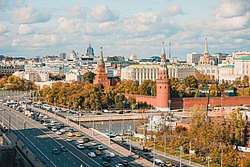
The site had been continuously inhabited by Finno-Ugric peoples since the 2nd century BC. The Slavs occupied the south-western portion of Borovitsky Hill as early as the 11th century, as evidenced by a metropolitan seal from the 1090s which was unearthed by Soviet archaeologists in the area. The Vyatichi built a fortified structure (or "grad") on the hill where the Neglinnaya River flowed into the Moskva River.
Up to the 14th century, the site was known as the 'grad of Moscow'. The word "Kremlin" was first recorded in 1331[2] (though etymologist Max Vasmer mentions an earlier appearance in 1320[3]). The grad was greatly extended by Prince Yuri Dolgorukiy in 1156, destroyed by the Mongols in 1237 and rebuilt in oak in 1339.[4]
Seat of grand dukes
Dmitri Donskoi replaced the oak walls with a strong citadel of white limestone in 1366–1368 on the basic foundations of the current walls;[4] this fortification withstood a siege by Khan Tokhtamysh. Dmitri's son Vasily I resumed construction of churches and cloisters in the Kremlin. The newly built Cathedral of the Annunciation was painted by Theophanes the Greek, Andrei Rublev, and Prokhor in 1406. The Chudov Monastery was founded by Dmitri's tutor, Metropolitan Alexis; while his widow, Eudoxia, established the Ascension Convent in 1397.
Residence of the tsars
Grand Prince Ivan III organised the reconstruction of the Kremlin, inviting a number of skilled architects from Renaissance Italy, including Petrus Antonius Solarius, who designed the new Kremlin wall and its towers, and Marcus Ruffus who designed the new palace for the prince. It was during his reign that three extant cathedrals of the Kremlin, the Deposition Church, and the Palace of Facets were constructed. The highest building of the city and Muscovite Russia was the Ivan the Great Bell Tower, built in 1505–08 and augmented to its present height in 1600. The Kremlin walls as they now appear were built between 1485 and 1495.[4] Spasskie gates of the wall still bear a dedication in Latin praising Petrus Antonius Solarius for the design.
After construction of the new kremlin walls and churches was complete, the monarch decreed that no structures should be built in the immediate vicinity of the citadel. The Kremlin was separated from the walled merchant town (Kitay-gorod) by a 30-meter-wide moat, over which Saint Basil's Cathedral was constructed during the reign of Ivan the Terrible. The same tsar also renovated some of his grandfather's palaces, added a new palace and cathedral for his sons, and endowed the Trinity metochion inside the Kremlin. The metochion was administrated by the Trinity Monastery, and contained the graceful tower church of St. Sergius, which was described by foreigners as one of the finest in the country.
During the Time of Troubles, the Kremlin was held by the Polish forces for two years, between 21 September 1610 and 26 October 1612. The Kremlin's liberation by the volunteer army of prince Dmitry Pozharsky and Kuzma Minin paved the way for the election of Mikhail Romanov as the new tsar. During his reign and that of his son Alexis and grandson Feodor, the eleven-domed Upper Saviour Cathedral, Armorial Gate, Terem Palace, Amusement Palace and the palace of Patriarch Nikon were built. Following the death of Alexis's son, Feodor, and the Moscow Uprising of 1682, Tsar Peter escaped with much difficulty from the Kremlin and as a result developed a dislike for it. Three decades later, Peter abandoned the residence of his forefathers for his new capital, Saint Petersburg.

Imperial period
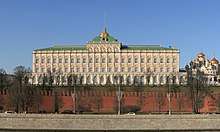
Although still used for coronation ceremonies, the Kremlin was abandoned and neglected until 1773, when Catherine the Great engaged Vasili Bazhenov to build her new residence there. Bazhenov produced a bombastic Neoclassical design on a heroic scale, which involved the demolition of several churches and palaces, as well as a portion of the Kremlin wall. After the preparations were over, construction was delayed due to lack of funds. Several years later the architect Matvey Kazakov supervised the reconstruction of the dismantled sections of the wall and of some structures of the Chudov Monastery, and built the spacious and luxurious Offices of the Senate, since adapted for use as the principal workplace of the President of Russia.
During the Imperial period, from the early 18th and until the late 19th century, the Kremlin walls were traditionally painted white, in accordance with fashion.[5]
French forces occupied the Kremlin from 2 September to 11 October 1812, following the French invasion of Russia. When Napoleon retreated from Moscow, he ordered the whole Kremlin to be blown up. The Kremlin Arsenal, several portions of the Kremlin Wall and several wall towers were destroyed by explosions and the Faceted Chamber and other churches were damaged by fire. Explosions continued for three days, from 21 to 23 October 1812. However, rain damaged the fuses, and the damage was less severe than intended. Restoration works were undertaken in 1816–1819, supervised by Osip Bove. During the remainder of the reign of Alexander I, several ancient structures were renovated in a fanciful neo-Gothic style, but many others, including all the buildings of the Trinity metochion, were condemned as "disused" or "dilapidated" and were torn down.
On visiting Moscow for his coronation festivities, Czar Nicholas I was not satisfied with the Grand Palace (alias Winter Palace), which had been erected in the 1750s to the design of Francesco Rastrelli. The elaborate Baroque structure was demolished, as was the nearby church of St. John the Precursor, built by Aloisio the New in 1508 in place of the first church constructed in Moscow. The architect Konstantin Thon was commissioned to replace them with the Grand Kremlin Palace, which was to rival the Winter Palace in St. Petersburg in its dimensions and in the opulence of its interiors. The palace was constructed in 1839–1849, followed by the re-building of the Kremlin Armoury in 1851.
After 1851 the Kremlin changed little until the Russian Revolution of 1917; the only new features added during this period were the Monument to Alexander II and a stone cross marking the spot where in 1905 Grand Duke Sergei Alexandrovich of Russia was assassinated by Ivan Kalyayev. These monuments were destroyed by the Bolsheviks in 1918.
Soviet period and beyond
The Soviet government moved from Petrograd to Moscow on 12 March 1918. Vladimir Lenin selected the Kremlin Senate as his residence. Joseph Stalin also had his personal rooms in the Kremlin. He was eager to remove all the "relics of the tsarist regime" from his headquarters. Golden eagles on the towers were replaced by shining Kremlin stars, while the wall near Lenin's Mausoleum was turned into the Kremlin Wall Necropolis.
The Chudov Monastery and Ascension Convent, with their 16th-century cathedrals, were dismantled to make room for the military school. The Little Nicholas Palace and the old Saviour Cathedral were pulled down as well. The residence of the Soviet government was closed to tourists until 1955. It was not until the Khrushchev Thaw that the Kremlin was reopened to foreign visitors. The Kremlin Museums were established in 1961, and the complex was among the first Soviet patrimonies inscribed on the World Heritage List in 1990.
Although the current director of the Kremlin Museums, Elena Gagarina (Yuri Gagarin's daughter) advocates a full-scale restoration of the destroyed cloisters, recent developments have been confined to expensive restoration of the original interiors of the Grand Kremlin Palace, which were altered during Stalin's rule.
State Kremlin Palace
.jpg)
The State Kremlin Palace (alias Kremlin Palace of Congresses), was commissioned by Nikita Khrushchev as a modern arena for Communist Party meetings, and was built within the Kremlin walls 1959–1961. Externally the palace is faced with white marble and the windows are tinted and reflective. The construction of a large modern public building in a historic neighborhood generated an uproar, especially since the building replaced several heritage buildings including the old neo-classical building of the State Armory and some of the rear parts of the Great Kremlin Palace. Although this was not the first time that the Soviet government had destroyed architectural heritage (notably the Chudov Monastery and Ascension Cloisters) in the Kremlin and in the country in general, by the mid 1950s laws were in place effectively considering all pre-Soviet constructions as historical monuments and preventing their demolition, in some ways making the construction illegal. Nevertheless, the Palace was integrated into the larger complex of the Great Kremlin Palace with walkways linking it to the Patriarchal Chambers and the Terem Palace.
Buildings

The existing Kremlin walls and towers were built by Italian masters from 1485 to 1495. The irregular triangle of the Kremlin wall encloses an area of 275,000 square metres (2,960,000 sq ft). Its overall length is 2,235 metres (2,444 yards), but the height ranges from 5 to 19 metres (16 to 62 ft), depending on the terrain. The wall's thickness is between 3.5 and 6.5 metres (11 and 21 ft).
Originally there were eighteen Kremlin towers, but their number increased to twenty in the 17th century. All but three of the towers are square in plan. The highest tower is the Troitskaya, which was built up to its present height of 80 metres (260 ft) in 1495. Most towers were originally crowned with wooden tents; the extant brick tents with strips of colored tiles go back to the 1680s.
Cathedral Square is the heart of the Kremlin. It is surrounded by six buildings, including three cathedrals. The Cathedral of the Dormition was completed in 1479 to be the main church of Moscow and where all the Tsars were crowned. The massive limestone façade, capped with its five golden cupolas, was the design of Aristotele Fioravanti. Several important metropolitans and patriarchs are buried there, including Peter and Makarii. The gilded, three-domed Cathedral of the Annunciation was completed next in 1489, only to be reconstructed to a nine-domed design a century later. On the south-east of the square is the much larger Cathedral of the Archangel Michael (1508), where almost all the Muscovite monarchs from Ivan Kalita to Ivan V of Russia are interred. (Boris Godunov was originally buried there, but was moved to the Trinity Monastery.)
There are two domestic churches of the Metropolitans and Patriarchs of Moscow, the Church of the Twelve Apostles (1653–1656) and the exquisite one-domed Church of the Deposition of the Virgin's Robe, built by Pskov artisans from 1484–1488 and featuring superb icons and frescoes from 1627 and 1644.
The other notable structure is the Ivan the Great Bell Tower on the north-east corner of the square, which is said to mark the exact centre of Moscow and resemble a burning candle. Completed in 1600, it is 81 metres (266 feet) high. Until the Russian Revolution, it was the tallest structure in the city, as construction of buildings taller than that was forbidden. Its 21 bells would sound the alarm if any enemy was approaching. The upper part of the structure was destroyed by the French during the Napoleonic Invasion and has been rebuilt. The Tsar bell, the largest bell in the world, stands on a pedestal next to the tower.
The oldest secular structure still standing is Ivan III's Palace of Facets (1491), which holds the imperial thrones. The next oldest is the first home of the royal family, the Terem Palace. The original Terem Palace was also commissioned by Ivan III, but most of the existing palace was built in the 17th century. The Terem Palace and the Palace of Facets are linked by the Grand Kremlin Palace. This was commissioned by Nicholas I in 1838. The largest structure in the Kremlin, it cost an exorbitant sum of eleven million rubles to build and more than one billion dollars to renovate in the 1990s. It contains dazzling reception halls, a ceremonial red staircase, private apartments of the tsars, and the lower storey of the Resurrection of Lazarus church (1393), which is the oldest extant structure in the Kremlin and the whole of Moscow.
The northern corner of the Kremlin is occupied by the Arsenal, which was originally built for Peter the Great in 1701. The southwestern section of the Kremlin holds the Armoury building. Built in 1851 to a Renaissance Revival design, it is currently a museum housing Russian state Regalia and Diamond Fund.
The haloalkaliphilic methylotrophic bacterium Methylophaga murata was first isolated from deteriorating marble in the Kremlin.[6]
Helipad
In order to stop the disruptions to Moscow traffic caused by motorcades, President Vladimir Putin authorized the construction of the Kremlin helipad. The helipad was completed in May 2013. The President will now commute back and forth to the Kremlin using a Mil Mi-8 helicopter. Careful consideration was taken in choosing the location of the helipad; the location chosen is said to be of no threat to the architecture of the Kremlin.[7][8]
Moscow Metro
The nearest Moscow Metro stations to the Kremlin are: Okhotny Ryad and Biblioteka Imeni Lenina (Sokolnicheskaya Line), Teatralnaya (Zamoskvoretskaya Line), Ploshchad Revolyutsii (Arbatsko-Pokrovskaya Line), Arbatskaya (Arbatsko-Pokrovskaya Line), Alexandrovsky Sad (Filyovskaya Line), and Borovitskaya (Serpukhovsko-Timiryazevskaya Line).
References
Specific
- "Кремль" [Kremlin]. Vasmer Etymological dictionary.
- Agrawal, Premendra (4 February 2012). Silent Assassins Jan 11, 1966. Agrawal Overseas. p. 184. ISBN 9789350878453. Retrieved 13 August 2015.
- Фасмера, Макс. "Этимологический Словарь Фасмера" [Vasmer's Etymological Dictionary] (in Russian). p. 321.
- Paul, Michael C. (January 2004). "The Military Revolution in Russia 1550–1682". The Journal of Military History. 68 (1): 31. doi:10.1353/jmh.2003.0401.
- Semenko, Xenia (25 November 2013). "Почему кремлевские стены красили в белый цвет" [Why the Kremlin walls painted white]. Rossiyskaya Gazeta (in Russian). Retrieved 18 May 2017.
- Doronina NV; Li TsD; Ivanova EG; Trotsenko IuA. (2005). "Methylophaga murata sp. nov.: a haloalkaliphilic aerobic methylotroph from deteriorating marble". Mikrobiologiia. 74 (4): 511–9. PMID 16211855.
- "Fly me to the Kremlin: Putin to commute to work by chopper". RT. 16 May 2013. Retrieved 9 August 2016.
- Rosenberg, Steve (27 May 2013). "Vladimir Putin gets Kremlin helipad to ease congestion" (Embedded video). BBC News. Retrieved 18 May 2017.
Bibliography
- Ivanov, Vladimir N. (1971). Московский Кремль [Moscow's Kremlin] (in Russian). Moscow.
- Merridale, Catherine (2013). Red Fortress: History and Illusion in the Kremlin. New York: Henry Holt. pp. 505. ISBN 9780805086805.
- Nenakormova, Irina S. (1987). Государственные музеи Московского Кремля [Art treasures from the Museums of the Moscow Kremlin] (in Russian). Moscow: Iskusstvo.
External links
| Wikimedia Commons has media related to Moscow Kremlin. |
| Wikivoyage has a listing for the Moscow Kremlin. |
- tour-planet.com – Sights of the Moscow Kremlin
- Travel2moscow.com – Official Moscow Guide
- History of the Kremlin
- Moscow Kremlin State Historical and Cultural Museum Sanctuary
- Open Kremlin
- Rare access inside the Kremlin, video news report from BBC News Online, 17 January 2013
- Cynthia Marsh. "Kremlin". Words of the World. Brady Haran (University of Nottingham).
